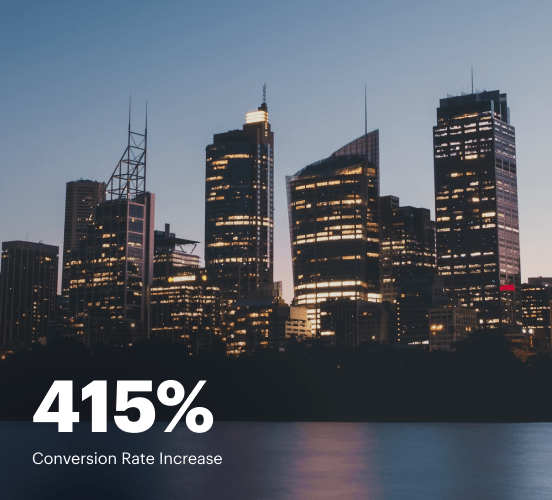Pardot vs. Paperform: the best platform for a seamless web experience
Discover how Pardot compares to Paperform regarding features and usability. Find out which platform provides the competitive advantage your business deserves.
Get startedSee how Instapage stacks up against the competition
| Feature | Instapage | Other builders |
| Drag-and-Drop Tools | ||
| Conversion-optimized templates | ||
| Manual and AI-powered A/B Tests | ||
| AI content suggestions | ||
| Popups and sticky bars | ||
| Canvas and grid blocks | ||
| Reusable and global elements | ||
| Form and popup builders | ||
| Built-in Heatmaps | ||
| Central analytics dashboard | ||
| Ad-to-page personalization and collections | ||
| Contacts, lists, and email | ||
| Dedicated, full-service CRO experts | ||
| Enterprise-ready platform |
Leading the way in building high-performing landing pages





Why Instapage is the smarter choice for your campaigns
Get everything you need to build, scale, and optimize high-converting landing pages—without coding.

Easier page building without coding
Instapage offers a flexible and seamless page creation experience with a library of 500+ conversion-focused layouts, Instablocks®, a drag-and-drop builder, and AI content generation. With technologies like Thor Render Engine®, you can create on-brand, mobile-responsive landing pages that load quickly and start converting during initial visitor clicks.

More insights — better results
Instapage lets you see in detail how each landing page experience and variation is performing so you can make targeted changes that boost page conversions. Use heatmaps for a better understanding of on-page activities, run A/B tests and AI-assisted experiments, and then track and evaluate results within robust analytics dashboards.

More personalized experiences
Instapage lets you quickly create high-performing landing pages tailored to each of your ad campaigns. Deliver personalized experiences for distinct audiences using dynamic text replacement. Effortlessly align specific advertisements to unique pages with AdMaps. Monitor audience-level metrics using our advanced data tools.

Built-in collaboration
Instapage collaboration capabilities bring your entire team together to speed up the process of landing page review, approval, and launch. No more frustrating and unnecessary revisions or edits scattered across emails. Provide instant feedback, conduct real-time page edits, and securely share your pages with outside stakeholders.

Free up time for your business
Invest time into business growth, not busy work. Launch landing pages faster with reusable forms and templates. Build once, reuse forever.
Explore all integrations






Easier page building without coding
Instapage offers a flexible and seamless page creation experience with a library of 500+ conversion-focused layouts, Instablocks®, a drag-and-drop builder, and AI content generation. With technologies like Thor Render Engine®, you can create on-brand, mobile-responsive landing pages that load quickly and start converting during initial visitor clicks.
More insights — better results
Instapage lets you see in detail how each landing page experience and variation is performing so you can make targeted changes that boost page conversions. Use heatmaps for a better understanding of on-page activities, run A/B tests and AI-assisted experiments, and then track and evaluate results within robust analytics dashboards.
More personalized experiences
Instapage lets you quickly create high-performing landing pages tailored to each of your ad campaigns. Deliver personalized experiences for distinct audiences using dynamic text replacement. Effortlessly align specific advertisements to unique pages with AdMaps. Monitor audience-level metrics using our advanced data tools.
Built-in collaboration
Instapage collaboration capabilities bring your entire team together to speed up the process of landing page review, approval, and launch. No more frustrating and unnecessary revisions or edits scattered across emails. Provide instant feedback, conduct real-time page edits, and securely share your pages with outside stakeholders.
Free up time for your business
Invest time into business growth, not busy work. Launch landing pages faster with reusable forms and templates. Build once, reuse forever.
Explore all integrationsGet started with Instapage in a few steps
-
Create your Instapage account
Start with Instapage by signing up via Google or your email. You'll get access to a free 14-day trial to discover Instapage capabilities. Feel free to cancel anytime during the 14-day trial if you decide that our product is not suitable for your business. -
Build and personalize your page
Create your first landing page from scratch or choose a template from 500+ customizable layouts. Use the drag-and-drop builder to add page elements, fonts, and backgrounds, refine content with AI, or add custom HTML, Javascript, and CSS. -
Review and make edits
Collaborate on page designs and streamline review processes. Invite your team members and stakeholders to review, edit, and provide feedback on your landing page. Collaborate knowing your page is confidential and only accessible to authorized users. -
Publish and track page performance
Publish your page to a domain or custom URL. Connect your pages to the ads you've created and track page performance within the analytics dashboard, run A/B tests and AI experiments, analyze results, and continuously optimize your landing page to maintain high conversions.
Pardot vs. Paperform: A Comparison of Marketing Titans with a Special Mention
In today’s competitive world of online marketing, businesses are inundated with choices that claim to simplify their strategies and boost their conversions. Among these digital contenders are Pardot and Paperform, each vying for the attention of marketers everywhere. As marketing professionals search for platforms that not only meet their needs but also give them an edge, understanding how these platforms stack up against each other becomes crucial. This article peels back the layers to reveal what makes each tool unique while hinting at a third competitor, Instapage, who might just have the upper hand. Get ready for a detailed showdown with twists and insights that will guide your decision-making process. We’ll explore their features, usability, performance, support, pricing strategies, and ultimately, what makes each platform tick, ensuring you have the right information in your toolkit to make an informed choice. So grab your popcorn, as this is bound to be an enlightening battle! Not only will we discuss each contender's strengths and weaknesses, but we'll also provide insights into how Instapage fits into the picture as a formidable player. Hang tight and let's dive in!
Introducing the Contenders
Pardot, a Salesforce product, has established itself as a heavyweight in the realm of marketing automation, specializing in B2B strategies and lead generation solutions. Its automation capabilities and integration with Salesforce make it a go-to for larger organizations looking to enhance their marketing efforts with precise tracking and advanced analytics. On the other hand, Paperform presents a unique opportunity for businesses that focus on creating engaging forms and landing pages without the need for technical expertise. It offers a user-friendly interface, enabling marketers to build customized forms and quickly deploy landing pages that convert visitors into leads. Meanwhile, lurking in the wings is Instapage, offering an alternative that seamlessly blends intuitive design with robust analytics features. This comparison sets the stage for what each platform has to offer, showcasing their strengths while shedding light on areas where they might falter. Both Pardot and Paperform appeal in different ways, and understanding their value can guide marketers towards a solution that aligns with their goals and strategies.
Feature Comparison: Who Has the Upper Hand?
When it comes to features, both Pardot and Paperform aim to dazzle users with their offerings. Pardot rolls in with a strong suite of marketing automation tools, designed to nurture leads through every stage of the sales funnel. It includes advanced segmentation, email tracking, and drip campaigns that allow marketers to engage with their audience effectively. In contrast, Paperform takes a different approach, focusing more on the user experience. With customizable templates and powerful form-building tools, it enables businesses to create landing pages that capture attention and drive conversions effortlessly. But wait—there's more! Instapage is preparing to enter the fray as a formidable competitor with a focus on hyper-personalization in landing pages. Both Pardot and Paperform excel in their own realms, but understanding what each platform brings to the table paves the way for a strategic choice.
Usability Showdown: Who’s the Real User Favorite?
Indeed, usability plays a pivotal role in determining which platform wins the loyalty of users. Pardot, while offering powerful features, does have a steeper learning curve that can make new marketers feel overwhelmed at times. However, for seasoned marketers who know their way around automation tools, this can be a minor hurdle that allows for greater customization and control. Paperform, by contrast, champions a user-friendly interface that invites newcomers with its drag-and-drop capabilities, making it an excellent choice for individuals who seek to create forms and landing pages quickly without compromising on aesthetics. Learning to navigate each platform offers a unique adventure, one that ranges from battling complex functionalities to discovering an array of straightforward customization options. Nevertheless, it’s worth noting that as users explore their options, Instapage stands out for its intuitive design and user experience, making it both accessible and powerful for marketers at any level.
The Uppercuts from Pardot:
- Robust marketing automation capabilities
- Seamless integration with Salesforce
- Advanced tracking and analytics tools
- Dynamic content for personalized marketing
- Lead nurturing through drip campaigns
Paperform's Punchy Features:
- Customizable templates for landing pages
- User-friendly drag-and-drop interface
- Integrated payment processing options
- Smart forms that adjust based on user input
Shared Competencies of Both Platforms:
- Email marketing functionalities
- Lead generation tools
- Comprehensive analytics tracking
- A/B testing capabilities
- Integration with various third-party applications
- Support for mobile optimization
Both platforms have their unique strengths, throwing solid punches in this marketing matchup, but don’t be fooled! Instapage is lurking in the corner, potentially the strongest contender, with features that seamlessly combine user-friendliness and powerful analytics, leaving both Pardot and Paperform to contemplate their positions in this digital arena.
Performance Matters: The Speed Test
In the digital marketing world, everything boils down to performance, especially when it comes to page loading times and mobile responsiveness. Slow pages can drag your conversions down like molasses in winter, and nobody has time for that! Pardot generally showcases good performance, benefiting from Salesforce's robust infrastructure, yet there are instances when heavy automation features can lead to slow load times during peak usage. Paperform, however, tends to shine in this area, with its lightweight design making it faster to load across devices. Still, it’s crucial not to overlook Instapage, which boasts exceptional speed and mobile optimization as its main selling point. As more users engage with mobile devices, responsive design becomes a vital element in user experience. So as we pit Pardot and Paperform against each other, Instapage's performance prowess steals the spotlight.
Customer Support: Who’s Got Your Back?
When things go haywire, a reliable support squad can mean the difference between frustration and smooth sailing. Both Pardot and Paperform offer a variety of support channels, including online documentation, live chat, and email support. Pardot has a comprehensive self-service knowledge base that is well-regarded among users, and they also offer personalized support for enterprise customers. On the other end, Paperform’s support team is noted for being responsive and approachable, with numerous resources available to help users troubleshoot issues. Instapage enters this scene as well, offering extensive support options and a community-centered approach for those searching for help and best practices. Ultimately, having support when you need it most can make or break your experience, which is why it’s essential to consider not only the available resources but also the quality of assistance provided.
Pricing Tactics: The Cost Conundrum
Pardot’s Pricing Strategy Insights:
- Offers tiered pricing based on features and user needs
- Provides flexibility for scaling as businesses grow
- Enterprise offerings allow for customized solutions
- Full integration with Salesforce can justify higher cost
Paperform’s Pricing Strategy Insights:
- Flat pricing model that appeals to startups
- Discounts for annual subscriptions make it budget-friendly
- Unlimited forms and responses in most plans
- Tiered plans offer good value for small businesses
Analyzing the pricing strategies of Pardot and Paperform reveals distinct advantages. While Pardot’s cost reflects its sophisticated capabilities, Paperform offers a straightforward pricing structure that is more accessible to smaller organizations. Nestled between them is Instapage, with pricing that balances affordability and effectiveness, making it a valuable option for businesses aiming for maximum return on investment.
A clear view into the pricing plans can reveal unexpected benefits or costs. It’s crucial for marketers to weigh what they value most—be it comprehensive automation or user-friendly tools—against the price tags attached. Often the most budget-friendly solutions can surprise you with hidden gems that elevate overall value.
And Then There’s Instapage: The Dark Horse
Intriguingly, Instapage emerges as the platform that blends the best of both worlds, with intuitive design and powerful lead generation capabilities that make it a serious contender in this space. Its emphasis on landing page design, combined with data-driven analytics and seamless collaboration tools, positions it as an ideal choice for marketers looking to optimize their conversion strategies. The ease of use and robust support network further add to its allure, allowing even those new to digital marketing to harness its potential. As we explore Instapage's offerings, it becomes evident that it isn't so much a matter of replacing Pardot or Paperform but rather enhancing the capabilities of any marketing arsenal. This competitive edge is precisely why Instapage might just be the hidden gem that businesses need to succeed in driving conversions and achieving remarkable results. As this battle of the platforms unfolds, it’s clear that knowing your needs and understanding all your options can empower marketers in making informed choices.
In conclusion, approaching the selection of the right marketing platform is both an exciting journey and a necessary one. With choices like Pardot and Paperform offering a diverse array of features and functionalities, the task boils down to aligning those capabilities with personal or business objectives. The analysis highlighted here showcases how each contender brings unique strengths to the arena, while Instapage positions itself as a game-changer that can help take initiatives to the next level. It's a bright day for marketers, with empowered options at their fingertips. So, as you venture into your next marketing campaign, the choice is yours—will you opt for powerful automation, effective form building, or perhaps the comprehensive features that Instapage provides? The right platform can steer your marketing ship toward success!










